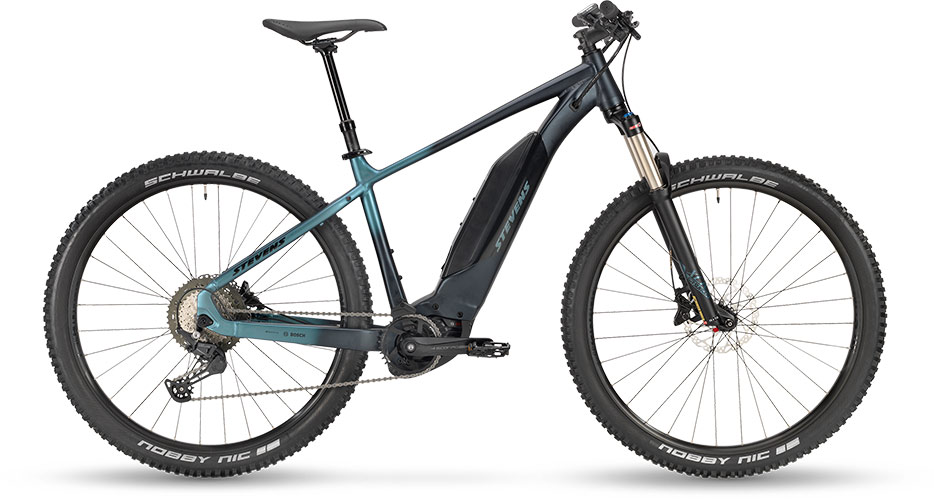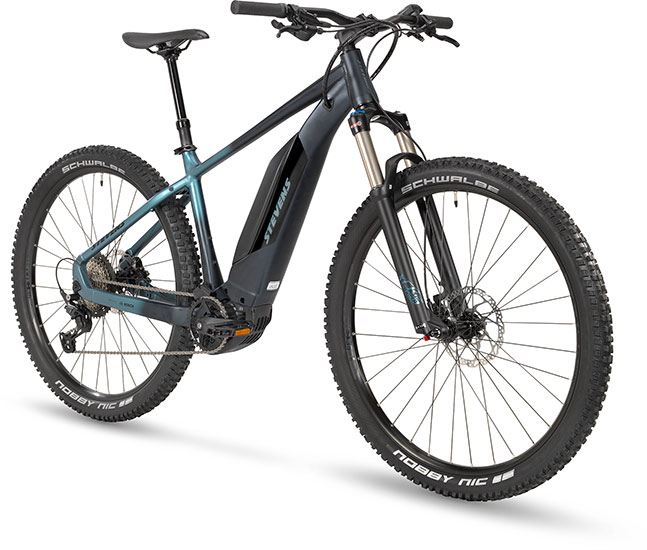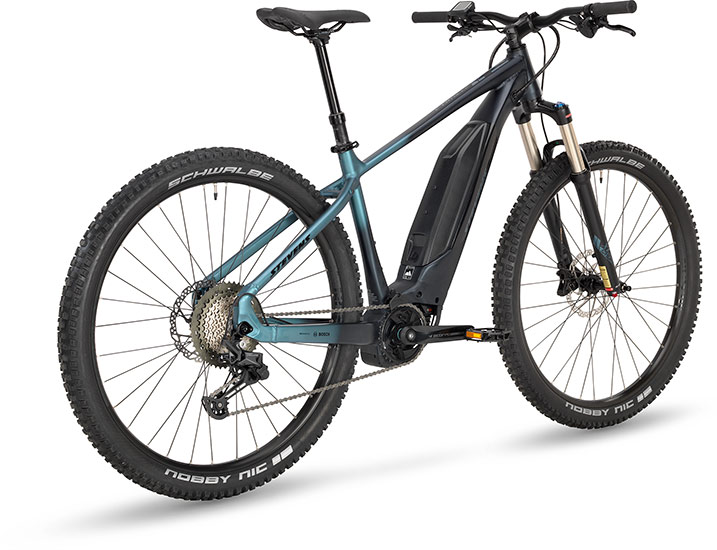 This page is from a former STEVENS Bikes model year (2021).
These pages are meant as a service in case you have questions about equipment and geometry of older STEVENS bikes.
You can pick other model years at Service – Product Years.
This page is from a former STEVENS Bikes model year (2021).
These pages are meant as a service in case you have questions about equipment and geometry of older STEVENS bikes.
You can pick other model years at Service – Product Years.
E-Cayolle
| Vægt | 21.8 kg |
|---|---|
| Ramme | Aluminium 6061 DB |
| Størrelser | 27,5" - 14" | 29" - 16", 18", 20", 22" |
| Color | Stone Blue |
Priser
- Vejl. Udsalgspris
- 2 999.00 €
Passionately mobile.
When you hop on the new E-Cayolle, you’ll immediately enjoy the energetic support of Bosch’s new top model Performance Line CX with up to 75 Newton meters of torque. It’s fed by the 500Wh PowerPack battery that’s semi-integrated into the down tube. When pedaling power is combined with that of the motor, you are pushed forward with full control as the bike is equipped with purely proven components. At just over 21kg, the E-Cayolle is THE lightweight among STEVENS' e-hardtails.
- Solid e-hardtail with comfort geometry and size-specific 27.5" or 29" wheels
- Bosch G4 Performance Line CX Cruise system w/ semi-integrated 500 Wh battery
- SR Suntour 120 mm air suspension fork
- Precise Shimano Deore 11-speed gears
- Trail-worthy Schwalbe Nobby Nic tires
Udstyr
Billederne kan afvige. Udstyr kan ændres på grund af problemer med forsyningskæden.
Chassis
-
 Ramme
Ramme
- Aluminium 6061 DB
-
- O.L.D.: 148 mm
- Brake: postmount disc 7"
- BB: Bosch
- Cable routing: internal
-
 Forgaffel
Forgaffel
- SR Suntour XCR34 Air LOR
-
- Travel: 120 mm
- Air suspension
- Lockout
- Tapered Steerer 1 1/8" - 1 1/2"
- O.L.D.: 110 mm
- Brake: postmount disc 7"
-
 Headset
Headset
- STEVENS MTB Taper 1 1/8"-1 1/2"
-
- Upper bearing cup: ZS44/28.6
- Lower bearing cup: ZS55/40
-
 Bremser
Bremser
- Shimano BR-MT420 | 410
-
- Hydraulic disc brake
- 4/2 pistons
- Rotor: SM-RT54
- Rotor size: 180/180 mm
- Center-Lock
Drivetrain
-
 Kranksæt
Kranksæt
- Oxygen E-Scorpo
-
- BB type: Bosch / ISIS
- Boost chain line
-
 Motorritzel
Motorritzel
- e*thirteen e*spec
-
- 34 T
- Narrow Wide
- Boost chain line
-
 Bagskifter
Bagskifter
- Shimano Deore Shadow+
-
- RD-M5100-SGS
- 11-speed
- Total capacity: 40 T
-
 Kæde
Kæde
- Shimano CN-HG601
-
 Kassette
Kassette
- Shimano Deore XT
-
- CS-M8000
- 11-speed
- Combination: 11-13-15-17-19-21-24-28-32-37-46 T
-
 Pedaler
Pedaler
- MTB Alu Flatpedal Reflex
E-System
-
 Motor
Motor
- Bosch G4 Performance Line CX Cruise
-
- Continuous rated power: 250 W
- Max. torque: 85 Nm
-
 Batteri
Batteri
- Bosch PowerPack 500
-
- Capacity: 500 Wh/13.4 Ah
- Voltage: 36 V
- Technology: Li-Ion
-
 Nedtuning ved
Nedtuning ved
- 25 km/h (15.5 mph)
-
 Rækkevidde
Rækkevidde
- See BOSCH Range Assistant
-
- Since the range of a pedelec depends on many factors, we recommend the BOSCH Range Assistant. For more information on pedelecs and their ranges see our FAQ, the frequently asked questions.
-
 Antal gear
Antal gear
- 4 drive modes with support levels 60-340 % plus walk assistance
Hjulsæt
-
 Nav
Nav
- Shimano MT400-B
-
- Axle: QR15x110/12x148 mm
-
 Fælge
Fælge
- Sun Ringlé Düroc TR35
-
- ETRTO: 31 x 584 | 31 x 622
-
 Dæk
Dæk
- Schwalbe Nobby Nic Performance
-
- Tire size: 70-584 | 65-622
- Foldable
- Addix compound
Cockpit
-
 Styr
Styr
- Oxygen E-Scorpo
-
- Width: 740 mm
- Backsweep: 9°
- Rise: 25 mm
- Clamp: 31.8 mm
-
 Frempind
Frempind
- Oxygen E-Scorpo
-
- Handlebar clamp: 31.8 mm
- Angle: 5°
-
 Sadel
Sadel
- Oxygen Havoc
-
 Sadelpind
Sadelpind
- Oxygen E-Scorpo DPR-E
-
- Travel: 125 mm | 150 mm | 170 mm
- Remote Lockout
- Length: 390 mm | 440 mm | 480 mm
- Diameter: 30.9 mm
- Insertion depth: 100 mm
-
 Skiftegreb
Skiftegreb
- Shimano Deore
-
- SL-M5100-R
- 11-speed
-
 Bremsehåndtag
Bremsehåndtag
- Shimano BL-MT401
-
- 2 finger
- Aluminium lever
-
 Display
Display
- Bosch Purion
Data
-
 Vægt
Vægt
- 21.8 kg
-
 Till. totalvægt
Till. totalvægt
- 140 kg
-
- Bike incl. rider, clothing and luggage
-
 Farve(r)
Farve(r)
- Stone Blue
-
 Størrelser
Størrelser
- 27,5" - 14" | 29" - 16", 18", 20", 22"
Test rapporter

Testsieg in My Bike!
06/2018
The Stevens impresses with a secure ride and uncomplicated handling, even on challenging terrain.

Komforttipp fürs E-Cayolle+
01/2018
Thanks to Plus tires and a long wheelbase, the E-Cayolle offers the greatest security and the best climbing ability in test.
Geometri

Online størrelsesrådgivning erstatter ikke rådgivning fra en specialforhandler. Den tjener som en indledende orientering og kan afvige fra personlige præferencer. En prøvetur giver den bedste sammenligning.
| Stelhøjde (") | 14 | 16 | 18 | 20 | 22 | Målemetode | |
|---|---|---|---|---|---|---|---|
| Hjulstørrelse (") | 27,5 | 29 | 29 | 29 | 29 | ||
| Saddelrørslængde | A1 | 654 | 675 | 679 | 689 | 707 | Nominel |
| Saddelrørslængde | A2 | 356 | 406 | 457 | 508 | 559 | Krankmidte til overk. Saddelrør |
| Saddelrørslængde | A3 | 324 | 366 | 392 | 418 | 443 | Krankmidte til overk. Overrør |
| Overrørslængde | B | 567 | 579 | 592 | 612 | 631 | |
| Overrør vandret | C | 560 | 580 | 600 | 625 | 650 | til skæringspunkt saddelpind |
| Kronrørsvinkel (°) | D | 68 | 68 | 68 | 68 | 68,5 | |
| Saddelrørsvinkel (°) | E | 74,5 | 74,5 | 74,5 | 74,5 | 74 | |
| Hjulafstand | F | 1119 | 1149 | 1169 | 1196 | 1210 | |
| Kædestiverlængde | G | 450 | 465 | 465 | 465 | 465 | |
| Kronrørslængde | H | 115 | 120 | 125 | 135 | 150 | |
| Krankforsænkning | I | 55 | 70 | 70 | 70 | 70 | Afstand til navhøjde* |
| Krankhøjde | K | 309 | 308 | 308 | 308 | 308 | Afstand til jorden* |
| Gaffelfrembøjning | L | 51 | 51 | 51 | 51 | 51 | |
| Slope | M | 314 | 287 | 272 | 257 | 250 | Overrør niveauforskel v/h |
| Radius hjul | N | 364 | 378 | 378 | 378 | 378 | Med dæk |
| Overrørshøjde | O | 719 | 754 | 772 | 793 | 814 | Overkant overrør til jorden** |
| Gaffelhøjde | P | 523 | 523 | 523 | 523 | 523 | Inkl. bundkoppen* |
| Afstand forhjul-krank | Q | 675 | 692 | 713 | 739 | 753 | |
| Reach | R | 385 | 400 | 419 | 441 | 454 | Vandret fra krank til kronrør |
| Stack | S | 630 | 650 | 655 | 664 | 680 | Lodret fra krank til kronrør |
| Stack/Reach (1:x) | 1,64 | 1,63 | 1,56 | 1,51 | 1,50 | Forhold fra Stack til Reach | |
| Saddelpind Ø | 30,9 | 30,9 | 30,9 | 30,9 | 30,9 | ||
| Frempindslængde | 60 | 60 | 70 | 80 | 90 | Midte-midte | |
| Frempindsvinkel (°) | 6 | 6 | 6 | 6 | 6 | ||
| Styrspænd | 31,8 | 31,8 | 31,8 | 31,8 | 31,8 | ||
| Spacerudstyr | 5 + 5 + 5 + 5 + 5 | ||||||
| Styrbredde | 740 | 740 | 740 | 740 | 740 | ||
| Pedalarmslængde | 170 | 170 | 170 | 170 | 170 | ||
| 14 | 16 | 18 | 20 | 22 | |||
* Med rytter og let fjederbelastet fjedergaffel (standard-køreposition)
** 1/3 væk fra saddelrøret, hjul ikke fjederbelastet



